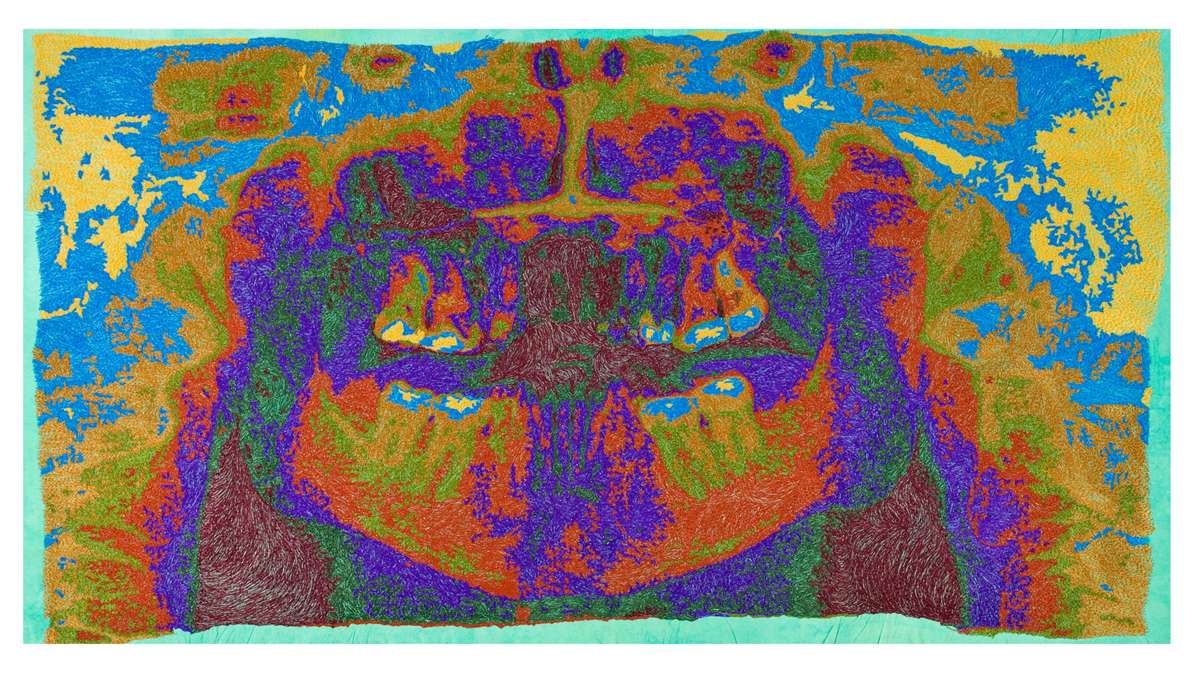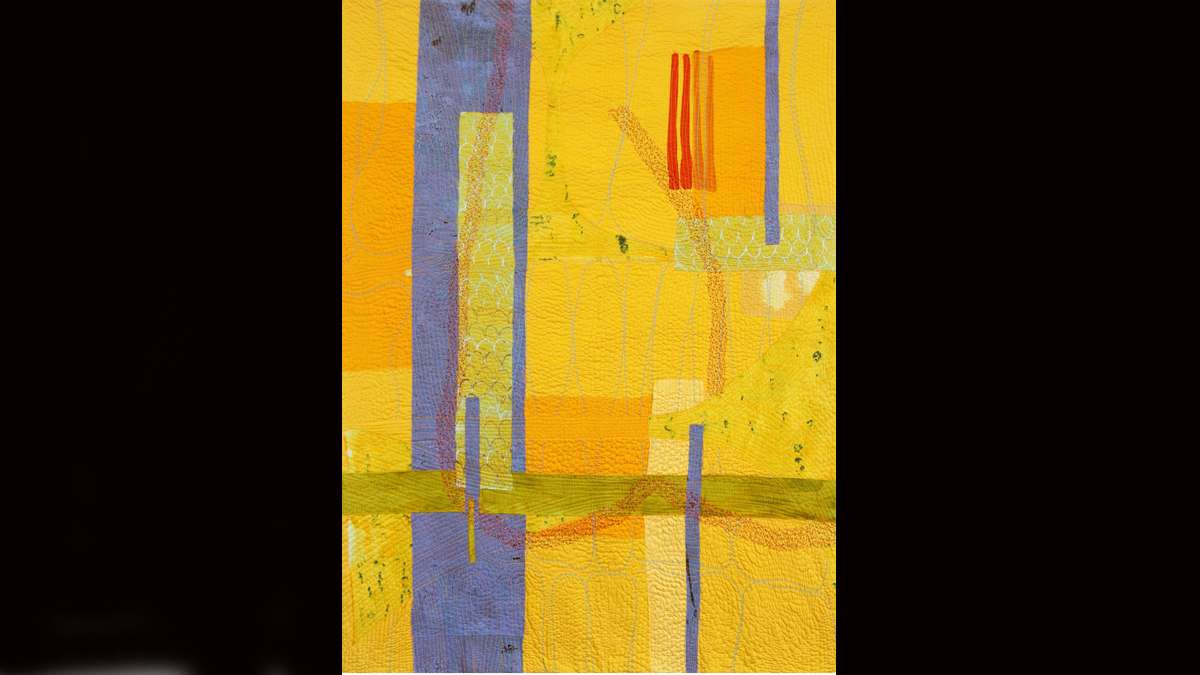Artists with a common thread stitched together in back-to-back exhibits
Several years ago, a group of artists at the Arts Council of Princeton organized a “Swap-O-Rama Rama,” a clothing swap and series of do-it-yourself workshops that creatively repurposed old clothing.
Led by Maria Evans, Madelaine Shellaby and others, participants brought a bag of worn garments to share. Sewing machines were set up and the stitchers worked at cutting up sleeves and dresses to make new garments. “People left with two or three… I wouldn’t want to call them outfits, but new pieces to add to their wardrobe,” said Evans, Artistic Director at the Arts Council.
Evans and Shellaby, former colleagues on the art faculty at Stuart Country Day School in Princeton, are both working this season on separate fiber art exhibitions.
Thread Bare, curated by Evans, features five artists who use textiles to preserve and protect their personal cultural perspective – it’s at the Paul Robeson Center for the Arts Oct. 10 through Nov. 23.
Shellaby is curating A View Within: A collaboration between two fiber artists at Gallery Art Times Two at the Princeton Brain and Spine Care Institute Nov. 15 through April 25, 2014, with a reception Dec. 6, 5-7 p.m.
Exhibit 1
“I’ve always been into fabrics and textiles and making my own clothes,” said Evans. “I love to see how people recycle fiber, such as in upcycled sweaters. That’s what my grandmother was doing in Ohio 40 years ago.” Evans’ grandmother not only taught her to sew but pickled, canned and made quilts. “Nothing was ever wasted. Old clothing was turned into tablecloths, blankets and pot holders.”
Evans’ grandmother had an enormous influence on her becoming an artist. “No artistic task was impossible – there was always a way to figure it out.”
Among the artists featured in Thread Bare are Marie Watt, who upcycles woolen blankets and uses them to tell stories. Watt’s work is about preserving her cultural identity – half Cowboy, half Indian. She creates sculpture and installations by cutting and then sewing the old blankets.
Quilt artist Michael Cummings celebrates African-American cultural heritage in his colorful layered works. Out of his Harlem, N.Y., brownstone, Cummings uses recycled prom dresses, shells and beads to create portraits of Sister Gertrude, Josephine Baker, African slaves and jazz musicians. Evans visited his studio, itself a work of art — a collage of his fiber materials, finished work and art collection, which includes Romare Bearden, a major influence. “He makes quilts as wide as his brownstone,” said Evans. “His work is as colorful, vibrant and full of fun as Harlem.”
Cummings’ “Sister Gertrude,” based on the New Orleans-based preacher, missionary, folk artist, musician, and poet who was active in the 1960s and 70s, uses wedding dresses Cummings acquired from thrift stores. “Satin Doll” uses prom gowns from thrift stores and beaded tassels swinging off the surface. The quilts combine hand and machine sewing and mixed media.
Upper Black Eddy, Pa., based artist Rebecca Reeves stitches protective “cocoons” around miniature furniture to protect them — little dishes, chairs, candlesticks and portraits obscured by thread. “You want to find out what they are,” said Evans.
Amy Orr, an organizer of Fiber Philadelphia, makes quilts and blankets from discarded credit cards and other materials found on Philadelphia streets. She has made a doll house of credit cards as well as a portrait of Chairman Mao. Bleached chicken bones, candy wrappers, bread twist ties and dollar bills find their way into her traditional quilt patterns. “She’s preserving 20th century culture using these urban artifacts,” said Evans. Orr will be giving a workshop at the Robeson Center Nov. 9.
Princeton-based, Israeli-born artist Ifat Shatzky has exhibited paintings locally, and Evans discovered she was crocheting wire, twine and nylon rope from Ace hardware. “The sewn pieces look like a human form, but one you’d find in the desert of a nomadic culture. You have to make sense of them. They look like elegant chain mail for women in earthlike tans, grays and browns. They’re so different from Cummings’ work yet similar in how they are showing the culture. They suggest garments or parts of the body – the brain tries to make sense of them.”
Exhibit 2
At Gallery Art Times Two, body imaging technologies – X-rays, Pet scans, MRIs – are used to provide a window into the human anatomy. California-based fiber artists Paula Chung and Karen Rips collaborate to re-interpret these images.
“I look at the original image and abstract it in my mind to lines, shapes and textures,” says Rips. “I then create the art piece through the use of my own hand-dyed, screen-printed and painted fabrics.” She uses both hand and machine stitching to create the final piece.
Chung manipulates the original film or digital images in Photoshop, prints and transfers them to a substrate medium, such as reinforced silk or screening, then stitches the images in polyester threads.
“Fiber is my medium of choice because it is tactile, easily manipulated, and allows itself to be altered in many different ways,” said Rips. “Tactile elements give even more reason to get up close and look at the art.”
Chung and Rips’ work is a perfect fit for the Brain and Spine Care Institute. “The technologies used in the work of the surgeons at PBSC are so much more than a medical tool,” said Shellaby. “They are fascinating as well as beautiful. The lay person does not immediately see the formal interest in the technologies and can be put off by them. So interpreting them so beautifully as Karen and Paula do is a good way to get this interest out there.”
___________________________________________________
The Artful Blogger is written by Ilene Dube and offers a look inside the art world of the greater Princeton area. Ilene Dube is an award-winning arts writer and editor, as well as an artist, curator and activist for the arts.
WHYY is your source for fact-based, in-depth journalism and information. As a nonprofit organization, we rely on financial support from readers like you. Please give today.










